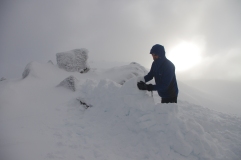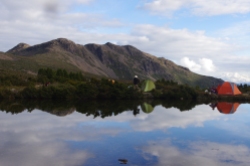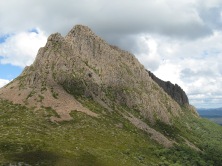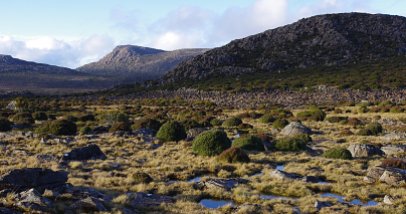Introduction
A note from Cam: The western faces of the Main Range of the Snowy Mountains contain the largest section of big skiing and riding terrain in Australia. In good snow conditions you can find runs of up to 1,000 metres of vertical.
While most serious backcountry skiers and riders have the western faces on their ‘to do’ list, do not underestimate the serious nature of the terrain. They contain steep and serious slopes, with cliffs and chutes, often in dangerously icy conditions. The main faces and ridges, such as Watsons Crags, are not suitable for beginner skiers and riders. Do not drop in to one of the major lines without scoping it first (eg from an opposite ridgeline) to ascertain how icy or wind affected it is, or whether it may be subject to avalanche danger. Do not ski/ ride here alone. Ensure you have all appropriate backcountry gear, including avalanche beacon/ probe/ shovel, and know how to use them. And be aware that even in spring like conditions, soft snow can quickly become dangerously icy in the afternoon as you climb out – I would recommend ski crampons as a minimum. Some teams also carry ice axes.
I would recommend you visit the area as part of a multi day trip (remember to bring the poo tubes!) so you have time to scope and then ski/ride the lines at the safest part of the day).
Be aware that whatever you do, you need to head UP to get help, not down into the trees. If injured or exhausted seek help via calling 000 rather than heading DOWN.
And make sure you check the MSC backcountry conditions report before heading out.
Watsons Crags Trip Report 2/7/14
This report comes from John Blankenstein.
It was only a few weeks ago snow forecasters were unsure as to the type of season that we were to have. Consensus between forecasters predicted a likely move towards El Nino with warmer than average daytime temps with less precipitation. There have been good El Nino years like 1991 and really bad years like 1982, 1993 and 2006. So with this in mind I was optimistic for a average season after all it is what it is, then just like that a series of cold fronts showed up on our door step and the season was officially here.
It’s been many years in the waiting for a combination of snow bearing lows like the ones which buffeted and unloaded over 6 feet of cold dry snow across the Australian Alps. The media was having a field day tagging the storms with names like “snow apocalypse” & “snowzilla”. Despite all the hysteria my eyes were clearly fixed on the movement of the high pressure system following these lows and the day time temperatures associated with this high. Wednesday the 2nd of July was looking exceptional and would be my first opportunity to get out back and see for myself. With over a meter of new snow and stable cold conditions I was excited about getting out deep on the western faces. Watson Crags have been on my bucket list for a while but due to less than average snow conditions in the last few years I have not been able to ride the Crags proper. Watson Crags is arguably the single most impressive mountain face in the Australian Alps. Watson Crags provides a big mountain experience that given the right conditions is as good as anything in Alaska, Japan and further abroad.
Starting out from Guthega I made good time to the top of Mt Twynam (2196m). From here i was greeted with a view of the best snow conditions I have ever seen this early in season on the main range. Game on.


Drunk on excitement I only had eyes for one line only “The Crags”. Skinning across the plateau I made good time to the Awesome Spur and my first look at the Crags. Completely covered from top to bottom I could not have asked for more. Fired up I sprinted across to the first main chute (as indicated in picture below). A few safety checks and I were on, dropping into my first back country line for season 2014.
The snow was holding good and was super dry on the top 200 meters providing some epic turns. A little variable in places, I rode the first 300 meters before deciding I would climb out and drop the bigger south western chute as indicated in the picture. Once on the “Crags Proper” as I like to refer to it, you’re confronted with a sight to behold as the fall line drops quickly over a convex roll and into the abyss. Committing to the fall line and over the convex your corralled into a series of tight chutes that sling shot you to the bottom of the mountain. The fall line here is around 55 degrees with some steeper icy pinches.
Dropping in, the mountain immediately starts to sluff. Sluff management is not common practice in AUS but essential on this line. Managing my turns I fly through a series of the best chutes I have ever ridden in Australia until I’m spat out at the bottom. This line is littered with the most awesome terrain and features from deep spines to tight chutes allowing for a real technical approach to big mountain snowboarding. Not the longest run in Australia, what the Crags gives up in vertical it makes up for with pure technical terrain.
The climb out is as rewarding and challenging as the descent. Several routes exist depending on conditions and level of skill. Variations in daytime temperature results in a fair bit ice fall and pin wheeling along the routes. Spin drift and icy shadows keep you company on the climb out. Good terrain assessment and management is key.




It is worth noting that in order to achieve these lines its take an exceptional level of fitness and a good degree of skill and experience specific to mountaineering. Avalanche awareness is crucial especially given the recent snow loading. Not a line for the average punter. Never enter the back country without the right climbing equipment such as crampons and axes and know how to use them. Ice and down climbing is a reality out here. Snow conditions are variable and the mountains remote. Good planning and training are paramount. Always let someone know before you head out and know where you’re going. The western faces are isolated and extreme.

My general gear list is the following:
· Phone
· E-purb
· GPS
· Compass (know how to use it)
· Map
· Beacon
· Shovel
· Probe
· Crampons
· Axe
· General riding equipment
My trip took me a little over 11 hours non-stop with approximately 2,500 vertical meters ascended and descended for the day.
























































July 7, 2014 at 9:39 am
Love the trip report John, awesome stuff
July 7, 2014 at 7:43 pm
great stuff, a goal of mine as well one day, cheers
July 8, 2014 at 9:51 am
Nice one John. Some lovely shots there. It is important to bear in mind trips we want to do “one day” when the snow cover is better, but even more important to be able to drop everything and do it when the conditions are right. And as always – safety first – assess before dropping in, and have a Plan B at all times. Well done. 🙂 Cheers, James Broadbent, NZ. (Author: NZ Backcountry Skiing)
July 14, 2014 at 5:39 pm
John, a pic of your line by James: http://ozbc.net/tr_sentinel020714.html
August 8, 2014 at 2:48 pm
Great pics